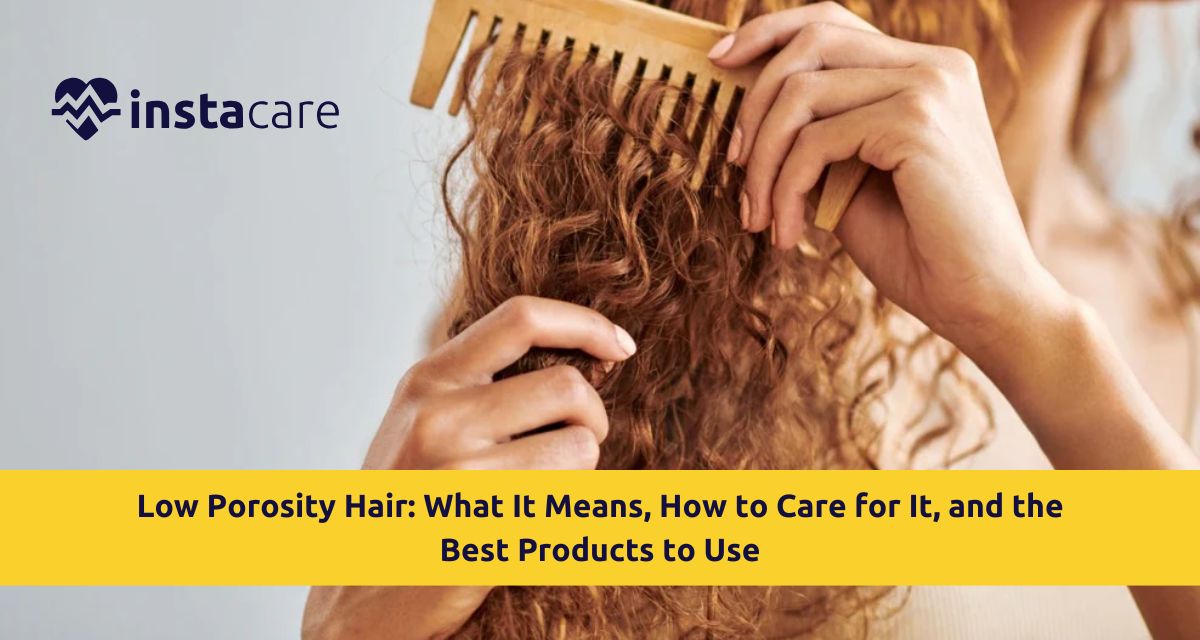What Is Low Porosity Hair?
Low porosity hair is hair whose layers of cuticles are shut tightly and do not absorb water. The flat cuticles are pressed against one another and pushed tightly and form a seal that the water or the products will not be able to pass through the hair shaft. Though it maintains the moisture seal in when it is absorbed, it also means that products aren't absorbed but rather stay on the hair surface. Low porosity hair vs high porosity hair is something you should understand while the low porosity hair isn't so quick in soaking in the moisture, the high porosity hair soaks in the moisture really fast but dries too fast because of more cuticles.
How to Identify If You Have Low Porosity Hair?
Knowing how to test hair porosity makes it easier to know your hair type. The most common is float test: put a fresh hair strand in water inside a glass. Low porosity hair floats or sinks very slowly because the closed cuticles won't let water penetrate. Some of the other low porosity hair traits are that products stay on your hair and don't get absorbed, water beading on your hairs, hours to dry naturally, and color treatments being difficult to get. Your hair will also be slightly waxy or slippery when wet and won't absorb oils and conditioners as well.
Causes of Low Porosity Hair
Low porosity hair is totally hereditary, dependent upon your natural hair texture. Certain individuals are just born with very closed cuticles, water-repelling naturally. Certain things do improve this, though. Mild levels of chemical processing, heat damage, or
stress induce cuticles to stick together. Repeated use of heavy silicones can also produce buildup that simulates or accentuates low porosity influences by covering more than the hair shaft, preventing penetration of moisture.
Challenges of Low Porosity Hair
Low porosity hair contains an inner set of problems. Buildup is easily at hand because oily creams and oils sit atop the surface and do not penetrate. The hair then looks greasy when, in reality, it is extremely dry on the inside. This is a hard one to get moisture balance in while the hair hates to absorb water, wet it will hold water but holds it much too slowly. Low porosity hair and protein overload is an all-too-familiar condition because excess protein dries the hair out and makes it brittle because closed cuticles interfere with the protein-moisture equilibrium. Deep conditioning doesn't work nearly as effectively when performed without heat, and styling products aren't accomplishing the work.
How to Care for Low Porosity Hair?
How to care for low porosity hair is a deliberate method with cuticle opening for the uptake of water. Heat is your friend use warm water and gentle heat for deep conditioning for low porosity hair. Steaming treatments work really well to open the cuticles without hurting them. Explaining each day, it cleans out dirt that prevents moisturizing penetration. Use light, water-based products which penetrate well. LOC method (Liquid, Oil, Cream) works, but use light oils and not too much. Avoid rich creams and rich butters that sit on hair and don't penetrate.
Best Hair Care Routine for Low Porosity Hair
An effective low porosity hair routine has cleansing, moisture, and protein in its fine balance. Clarifying shampoo every alternate week to get rid of buildup, and wash normally with sulfate-free shampoos. Condition damp hair in the warm shower or the hooded dryer 20-30 minutes. The greenhouse effect hot towel and plastic cap increases low porosity hair deep conditioning efficiency.
Low porosity hair moisture tips for moisturizing, layer product on wet hair immediately following shampoo when cuticles are open. Humectant leave-in conditioners containing glycerin or aloe vera. Apply low porosity hair oils sparingly light oils are best: argan, grapeseed, or sweet almond oil. Product seal minimally and air-dry hair or low heat. Between washings top off with water-based sprays instead of heavy product.
Best Ingredients for Low Porosity Hair
The best low-porosity hair products include some lightweight ingredients. Use water-based products with humectants such as glycerin, honey, and aloe vera that draw in water. Light water from oil cleansing emollients babassu oil, argan oil, and jojoba oil will not weigh your hair down. Low porosity hair treatment with natural remedies for low porosity hair such as rose water, green tea rinse, and diluted apple cider vinegar condition cuticles and restore pH balance.
Steer clear of heavy butters, petrolatum, and mineral oils that create barrier effects. Use protein treatments sparingly in low porosity hair care no more than once a month with hydrolyzed proteins instead of heavy
keratin treatments. Use ingredients such as panthenol (vitamin B5) and hydrolyzed silk that condition without heavy weighing of hair.
Common Mistakes to Avoid
The most common mistakes for low porosity hair turn your hair health around. The most common culprit is too much product less is more for low porosity hair. Putting oils on dry hair keeps moisture from coming through; put it on wet hair. Not clarifying regularly means buildup will block moisture from passing through to hair. Excessive use of protein treatments creates low porosity hair and protein excess, leaving your hair brittle and dry.
Avoid cold water rinses; despite so-called good sense, warm water best opens cuticles to deeper penetration of products. Avoid heavy creams or butters as styling products, substituting them with light gels or mousses instead. Never skip the use of heat on deep conditioning, for treatments at room temperature are nearly useless. Too many products stacked one on top of another does not benefit, they only build up.
Conclusion
Low porosity hair needs a solution engineered specifically to match heightened moisture penetration without build-up. Knowing low porosity hair type guides you through the challenge of choosing the right products and creating a successful low porosity hair regimen. The secret to it is employing heat in the right places, choosing light formuladas, and staying clear of pitfalls such as product build-up and heavy protein treatments. By adding great low porosity hair moisture tips and best low porosity hair products, your hair treatment process gets a boost. Quality not quantity of product great products for your level of porosity will work better than too much heavy product on your hair's surface.
Please book an appointment with the
best Dermatologist in Lahore, Karachi, Islamabad, and all major cities of Pakistan through
Instacare, or call our helpline at 03171777509 to find a verified doctor for your disease.

